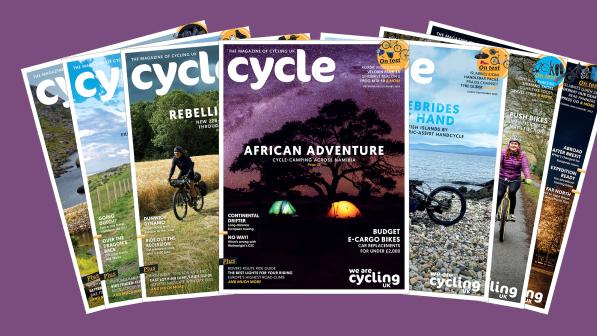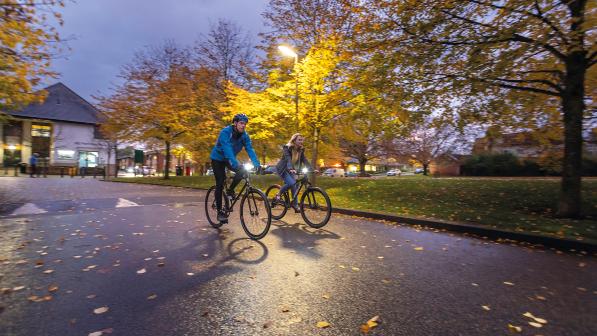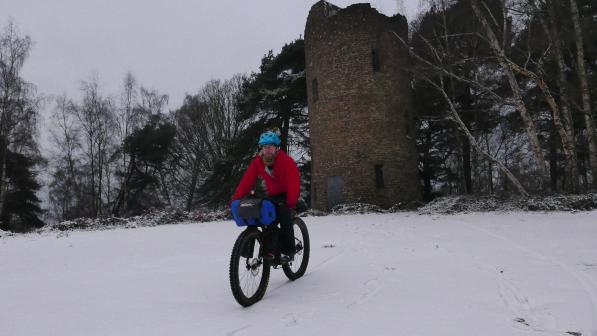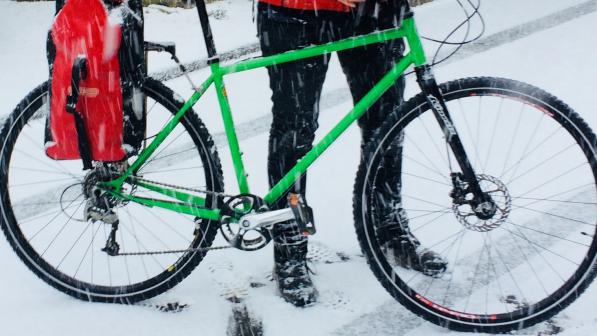Cycle hacks to try this winter

Getting out on the bike during the cold, dark winter months can be a challenge for many of us. Not to mention that the colder, wetter weather can mean extra care must be taken to protect our rides.
We’ve collected some of your favourite hacks and advice to prevent wear and tear on your cycle in the winter.
Beat cold feet
Place about 700g of ceramic baking beans in a suitable jug, then microwave them on high heat for four minutes. Pour them into cotton ankle socks (tip: put each sock in a tall glass, folding its cuff over the top).
Seal the tops of the socks with food bag clips, then place in your cycling shoes for a few minutes before riding. You can do the same with dry rice – just don’t eat it!

Frozen freehub pawls
Winter cold can cause the pawls to freeze in position in your bike’s freehub so there’s no drive. You just pedal air. If it happens on a ride, hot water on the freehub may free them.
Even the warm water from your own bladder can do the trick… Too icky? Didn’t work? Fasten the back of the cassette to the spokes with cable ties and pedal home very gently on your now fixed-wheel bike, using the lowest gear available.

Mudguards without mounts
Mudguards are essential for many if you’re planning to cycle off road or in rainy conditions, but many bikes lack frame mounts and/or clearance for full mudguards. Off-the-shelf solutions for road bikes include the SKS Raceblade Long and Crud Roadracer Mk3, but you can sometimes fit standard mudguards.
Use P-clips (search online for ‘Tortec P-clips’) to attach the stays, and fix the mudguard itself to the frame and fork with cable ties – through holes bored in the mudguard if necessary. If the mudguards won’t fit safely under the fork crown or seatstay bridge, saw them short so they end there.

Frame protection
Winter weather is tough on our bikes. The combination of rain, mud and salt from roads can cause a lot of damage. The best-looking way to protect a bike frame’s paintwork from rubbing and chipping is with transparent helicopter tape. (Tip: clean the frame with isopropyl alcohol to remove any grease, then warm the tape with a hairdryer.)
For a cheaper, DIY look, use electrical tape – black or roughly the same colour as the frame – or old innertube. The latter is great for: chainstay protection; preventing frame-bag wear; and deflecting down tube rock strikes off road.

Give disc brakes the business
Keeping your brakes running properly is important no matter the weather, but in winter your pads could be wearing down quicker if they get covered in dirt and salt, and even quicker if they are rubbing.
A business card, or similar size cut from a birthday card and so on, can be used to help adjust a disc brake so it doesn’t rub.
Remove the wheel. Fold the business card neatly over the rotor. Slot the folded card into the disc calliper. Replace the wheel. Loosen the brake calliper bolts. Squeeze the brake lever and hold it while tightening the calliper bolts. Release the lever. Remove the wheel and card, then replace the wheel. Spin it. All sorted?

Winter riding advice
So you’ve used our hacks above to get yourself and your cycle ready for the ride but there are a few more things that can make your trip that much more pleasant in winter.
Pack spare back up lights
Longer nights mean you’re more likely to be riding in the dark, particularly if you’re commuting. Don’t be caught out by lights you’ve forgotten to charge by always keeping a backup set.
It is illegal to cycle on a public road after dark without lights and reflectors. More on lighting regulations.
Never leave home without a waterproof
According to English author and fellwalker, Alfred Wainwright: “There’s no such thing as bad weather, only unsuitable clothing.” Cycling UK couldn’t agree more. So don’t let the rain stop you enjoying your ride.
Be sure to always have your waterproofs with you. Whether you opt for a cycling poncho or one that doesn’t take up too much space in your bag, there are options for all types of cyclist.
Layer up
The short answer to staying warm when riding in the winter is layers. The long answer is you need to know your own body because everyone is different. More advice on wearing the right clothing in winter
Spare clothes
Just in case you get caught out in the rain during your commute it’s a good idea to keep a dry set of clothes and shoes at work. If you usually cycle in your work attire this means no need to carry your spare clothes with you every day.
Plastic bags in the shoes
Using a plastic bag in your shoes is a great way to seal in the warmth. Most commonly, you can sandwich the plastic bag between two layers of socks. An alternative method is to put the plastic bag next to the skin, beneath the sock layers. It might not feel very nice, but it’s rumoured to be very effective at trapping heat.
Look after your fingers and toes
If you have Raynaud’s disease or are prone to cold fingers and toes it’s especially important to ensure that you keep your extremities warm while out cycling. Read our helpful tips and advice.
Be prepared
Make sure to always carry the means to fix a puncture – and know how to use it.
If you are riding at night it can be helpful to pack a headtorch, it’s far easier to repair things that way than holding your bike light between your teeth.
Long rides, take a thermos
There’s nothing quite like a hot drink at a café stop mid-way or after a cool ride. If you’re planning a long ride or you’re not near any cafés, think about taking your favourite hot beverage in a thermos to warm up your core while you’re out.
Keep your cycle clean
Winter is especially hard on your bike. Rain will wash debris to the roadsides, where you’re likely to be cycling through it. All that water isn’t good for metal parts, either, especially if gritters have been out spreading salt and grit. So your bike will thank you if you keep it clean and dry between rides.
Check out our advice on cleaning your bike and remember that Cycling UK members receive discounts on lots of products.
Wet lube on your chain
It’s important to swap your lube during winter. A dry lube is great for summer but you’ll want to switch to a wet lube for the winter.
Wet lubes are less likely to wash off in the rain but might collect more dirt so be sure to clean your chain more frequently.
Heat escapes from the top
Between 40-45% of body heat is lost through the head and neck so it’s vital to keep your head warm during winter rides.
If neck warmers, headbands, cycling caps, balaclava and woolly hats don’t quite cut it, try adding a swimming cap underneath. This additional layer can help trap heat and keep your head from getting chilly.
Got a cycle hack of your own?
Got a handy hack of your own? If so, we’d love to hear from you.





